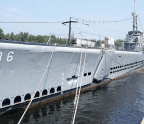
The submarine service presents a strategic ‘silent threat’ that can be used as part of an information operation to deter adversary access to the sea through awareness of their presence. Today, all submarine services wear a qualification badge – usually a set of dolphins. The Royal Navy first issued badges in the 1950s and then adopted the current insignia in 1972. Crew serving in ballistic missile boats wear a smaller badge depicting the bigger submarines.
Tactical awareness of an adversary was critical during the Cold War – the post-war period of geopolitical tension between the United States, the West and the then Soviet Union. During this time Soviet, US and UK nuclear submarines attempted to own the waters of the North Atlantic and Norwegian sea and the North Sea to prevent each other from operating near their territorial waters. US and UK submarines worked together to identify and chase Soviets away from the UK and the US east coast. The Soviets submarines included the Yankee-class, Project 667A Navaga, (navaga), the Delta-class and Typhoon ballistic boats. Their SSNs included the Sierra-class and Charlie-class and many diesel-electric boats. The US Navy’s ballistic submarines included the George Washington-class and more than 12 different classes of SSN. The British deployed the Polaris submarines of the Resolution-class as well as Churchill, Swiftsure-, Trafalgar-and Valiant-class hunter-killer subs.
They stalked each other at close quarters in the deep dark waters of the ocean – often suspecting they knew, but not knowing each other’s exact location. These challenging situations were often described as ‘warfare with your eyes shut’ and for those involved, it was intense, sometimes terrifying and constantly stressful. What is also very clear is that for most of the Cold War, submariners in the Royal Navy and US Navy were effectively operating on a war footing, in an environment where psychological pressure was immense and the risk of collision constant as subs shadowed each other.
There were, a 4,500-tonne Valiant-class nuclear submarine, with an unknown Soviet submarine in 1968, which rolled over to 65° and traumatised many of the crew. Then in 1981, HMS , a Swiftsure-class boat sustained severe damage in an impact that ripped away part of her forward casing deck and part of the fin. Submarines operate in a battlespace in which ‘acoustic noise’ provides the sonar signature of another boat and any mistake could be costly.






